Coronavirus (COVID-19): modelling the epidemic (issue no. 13)
Latest findings in modelling the Covid-19 epidemic in Scotland in terms of the spread of the disease through the population (epidemiological modelling).
This document is part of a collection
Coronavirus (COVID-19): modelling the epidemic in Scotland (Issue No. 13)
Background
This is a report on the Scottish Government modelling of the spread and level of Covid-19. This updates the previous publication on modelling of Covid-19 in Scotland published on 6 August 2020. The estimates in this document help the Scottish Government, the health service and the wider public sector plan and put in place what is needed to keep us safe and treat people who have the virus.
Now that numbers of deaths in Scotland are at a low level, this edition of the research findings focuses on the epidemic as a whole, looking at how many people in Scotland are likely to be infected with Covid at the present time, and in the next few weeks, and then goes on to introduce a new approach to modelling this point in the epidemic.
Key Points
- Modelling of the epidemic in Scotland estimates that on 7 August there were around 20 (15 - 35) new infections and around 250 (150 - 400) people who could be infectious with Covid-19. This is an underestimate. The cases from the outbreak in Aberdeen are in addition to this.
- There were 5 local authority areas which exceeded what would be expected at this stage in the epidemic in the last 7 days. These were Aberdeen City, Aberdeenshire, Glasgow City, Highland and Shetland. These are now returning to normal levels, however Aberdeen and Aberdeenshire are still exceeding what would be expected at this point in the epidemic.
- The reproduction rate R is becoming less certain, with the current range between 0.6 and 1.3 for Scotland.
Overview of Scottish Government Modelling
Epidemiology is the study of how diseases spread within populations. One way we do this is to use our best understanding of the way the infection is passed on and how it affects people who catch it to create mathematical simulations. Because people who catch Covid-19 have a the relatively long period in which they can pass it on to others before they begin to have symptoms, and that the majority of people infected with the virus will experience mild symptoms, this "epidemiological modelling" provides insights into the epidemic that cannot easily be measured through testing e.g. of those with symptoms, as it estimates the total number of new daily infections and infectious people including those who are asymptomatic or have mild symptoms.
Modelling also allows us to make short-term forecasts of what may happen with a degree of uncertainty. These can be used in health care and other planning. The modelling in this research findings is undertaken using different types of data which going forward aims to both model the progress of the epidemic in Scotland and provide early indications of where any changes are taking place.
Firstly, modelling outputs are provided here on the current epidemic in Scotland as a whole, based on daily deaths and other data. This includes modelled estimates of the numbers of new cases and infectious people. Because it takes a little over three weeks on average for a person who catches Covid-19 to show symptoms, become sick, and either die or recover, there is a time lag in what this model can tell us about any re-emergence of the epidemic and where in Scotland this might occur. However modelling of Covid deaths across the epidemic is an important measure of where Scotland lies in its epidemic as a whole. In additional the modelling groups which feed into the SPI consensus use a range of other data along with deaths in their estimates of R. These outputs are provided in the first part of this research findings.
Secondly, modelling is provided around short term forecasts and measures of whether what we are seeing exceeds what would be expected. This replaces the short term modelling of NHS capacity provided in these reports previously, as the focus at this stage of the epidemic is around identifying any possible re-emergence of the virus in Scotland rather than whether there is sufficient hospital capacity to treat large numbers of Covid cases. This type of modelling uses early indicator data such as testing, contact and movement data.
What the modelling tells us about the epidemic as a whole
Figure 1 shows how Rt has changed since February. Before the "stay at home" restrictions were put in place Rt was above 1, and most likely to have been between 4 and 6 before any interventions were put in place.
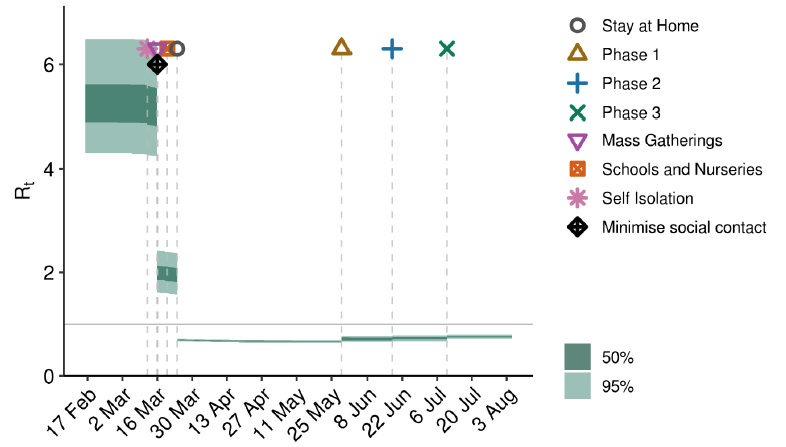
Source: Scottish Government modelled estimates using Imperial College model code; actual data from https://www.nrscotland.gov.uk/statistics-and-data/statistics/statistics-by-theme/vital-events/general-publications/weekly-and-monthly-data-on-births-and-deaths/deaths-involving-coronavirus-covid-19-in-scotland
The Rt value estimated by the Scottish Government falls within the range of values estimated by other modelling groups and considered by SPI-M and SAGE (Figure 2). SAGE's consensus view, as of 13 August, was that the value of Rt in Scotland was between 0.6 and 1.3. This rise is primarily due to the outbreak in Aberdeen. The various groups which report to SPI-M use different sources of data in their models (ie. deaths, hospital admissions, cases) so their success at capturing this outbreak varies from group to group, leading to an increase in uncertainty this week.
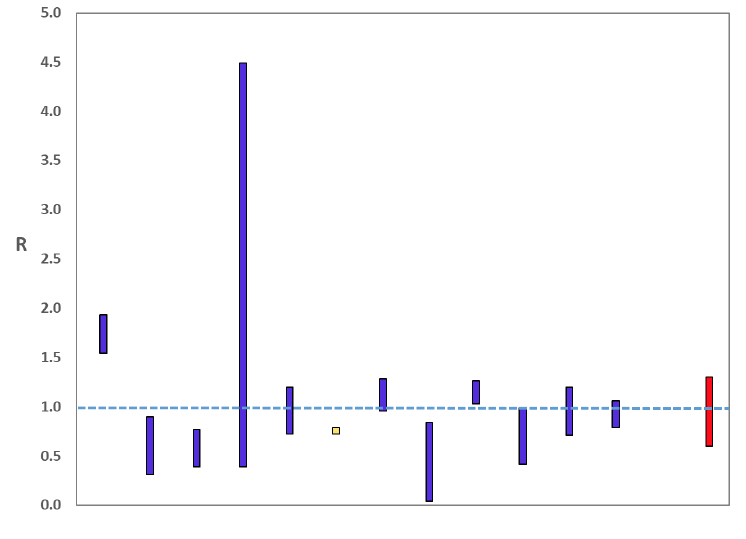
Source: ScFigure 2. Estimates of Rt for Scotland, as of 12 August, including 90% confidence intervals, produced by SAGE. The estimate produced by the Scottish Government is the 6th from left (yellow), while the SAGE consensus range is the right-most (red).ientific Advisory Group for Emergencies (SAGE).
The Scottish Government's epidemiological model estimates that on 7 August there were around 20 (15 - 35) new cases of Covid-19 in Scotland (see Table 1), while the number of people in Scotland who could be infectious on this date was around 250 (150 - 400) (see Table 2). Across Scotland estimates indicate this number is declining by around 23% each week, and will continue to decline at a similar rate over the next two weeks, apart from in Aberdeen and Aberdeenshire where cases have exceeded what was expected (see below).
| Estimated new daily infections | |||
|---|---|---|---|
| Date | Mid | Lower | Upper |
| 22 May | 525 | 415 | 670 |
| 29 May | 385 | 305 | 485 |
| 05 June | 275 | 210 | 350 |
| 12 June | 200 | 150 | 260 |
| 19 June | 150 | 110 | 195 |
| 26 June | 110 | 75 | 150 |
| 03 July | 80 | 55 | 115 |
| 10 July | 65 | 40 | 90 |
| 17 July | 50 | 30 | 70 |
| 24 July | 35 | 25 | 55 |
| 31 July | 30 | 15 | 40 |
| 07 August | 20 | 15 | 35 |
| 14 August | 20 | 10 | 25 |
| 21 August | 15 | 5 | 20 |
| Estimated Infectious Pool | ||||
|---|---|---|---|---|
| Date | Mid | Lower | Upper | Percentage Weekly Change |
| 22 May | 6800 | 5400 | 8575 | -32% |
| 29 May | 4650 | 3650 | 5950 | -31% |
| 05 June | 3375 | 2650 | 4300 | -28% |
| 12 June | 2450 | 1900 | 3150 | -27% |
| 19 June | 1800 | 1325 | 2350 | -27% |
| 26 June | 1350 | 950 | 1775 | -26% |
| 03 July | 1000 | 700 | 1350 | -26% |
| 10 July | 750 | 500 | 1050 | -25% |
| 17 July | 575 | 375 | 800 | -23% |
| 24 July | 450 | 275 | 650 | -23% |
| 31 July | 325 | 200 | 500 | -23% |
| 07 August | 250 | 150 | 400 | -23% |
| 14 August | 200 | 125 | 300 | -23% |
| 21 August | 150 | 100 | 250 | -23% |
Figure 3 shows the epidemiological model forecasts of daily deaths produced by the Scottish Government, given the present set of interventions. This measure of the epidemic is forecast to remain near zero in the weeks ahead.
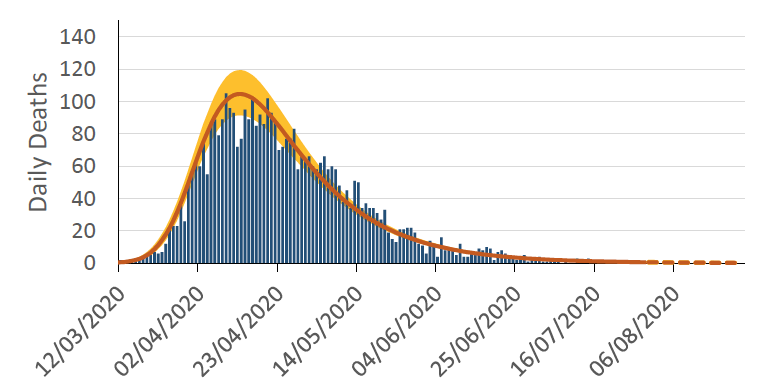
Source: Scottish Government modelled estimates using Imperial College model code; actual data from https://www.nrscotland.gov.uk/statistics-and-data/statistics/statistics-by-theme/vital-events/general-publications/weekly-and-monthly-data-on-births-and-deaths/deaths-involving-coronavirus-covid-19-in-scotland
This model is based on numbers of deaths, which have declined to very low levels. Because of this, other methods are needed to monitor outbreaks based on testing such as the one seen recently in Aberdeen, before any deaths occur. It is reassuring, however, that the number of actual cases recorded across Scotland in recent days remains within the range predicted by the model (Figure 4).
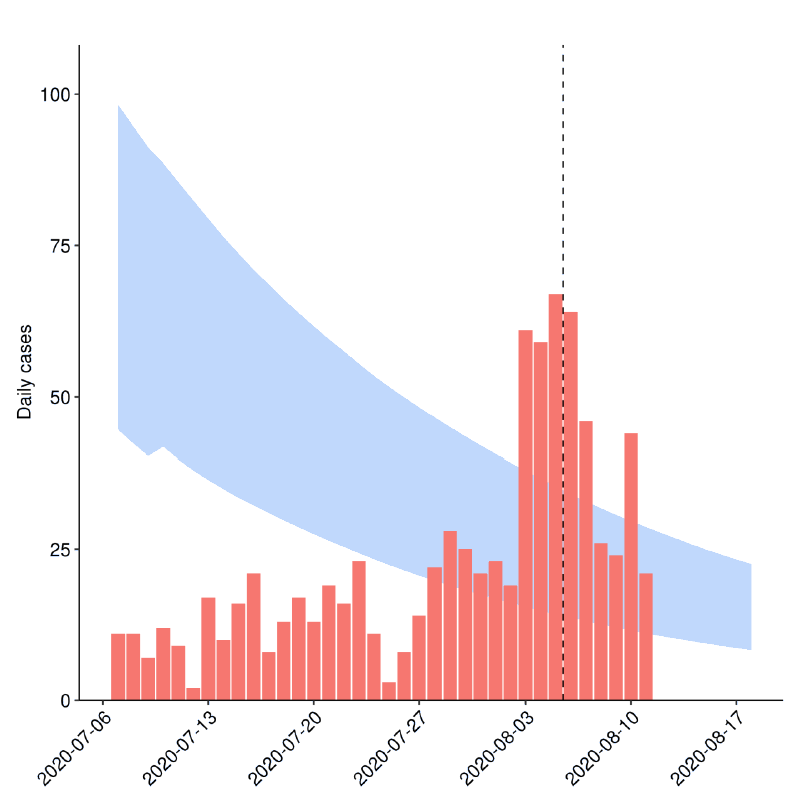
What the modelling tells us about whether Covid infections exceeded what would be expected at this stage in the epidemic
While metrics such as the reproductive rate - the R number - have been useful in guiding our response to Coronavirus so far, the models we use rely on numbers of deaths to track the epidemic. These have fallen to low levels, which means we need to find new ways to monitor trends in the epidemic. One of the ways we can do this is to calculate whether the number of confirmed infections (based on testing) in each area exceeds the number that was expected, given the number recorded across the country - this is called "exceedance". An analysis of trends across Local Authorities in Scotland has been developed by modellers at the University of Warwick on behalf of the Scottish Government.
Numbers of positive tests recorded each day, adjusted for population of each local authority and number of cases seen in preceding weeks, should fall within a certain distribution of values, which will rise and fall depending on the number of cases being seen nationally. Areas where the number of positive test results rise above the upper 95th percentile of this distribution may be at risk of seeing increased local transmission of Covid and heightened vigilance may be required.
In the week preceding 11August, across Scotland the epidemic in Scotland was driven by the outbreak seen in Aberdeen City and Aberdeenshire (Figures 5). Recent cumulative exceedance highlighted Aberdeen City (exceedance = 11.4), Aberdeenshire (8.7) as areas of higher risk of transmission, and Shetland Islands (5.0), Glasgow City (3.9), and Highland (3.6) as areas of which also have a raised risk (Figure 6). In most cases these are a reflection of a small number of cases, however the ongoing nature of the outbreak in Aberdeen and Aberdeenshire may be a cause for concern.
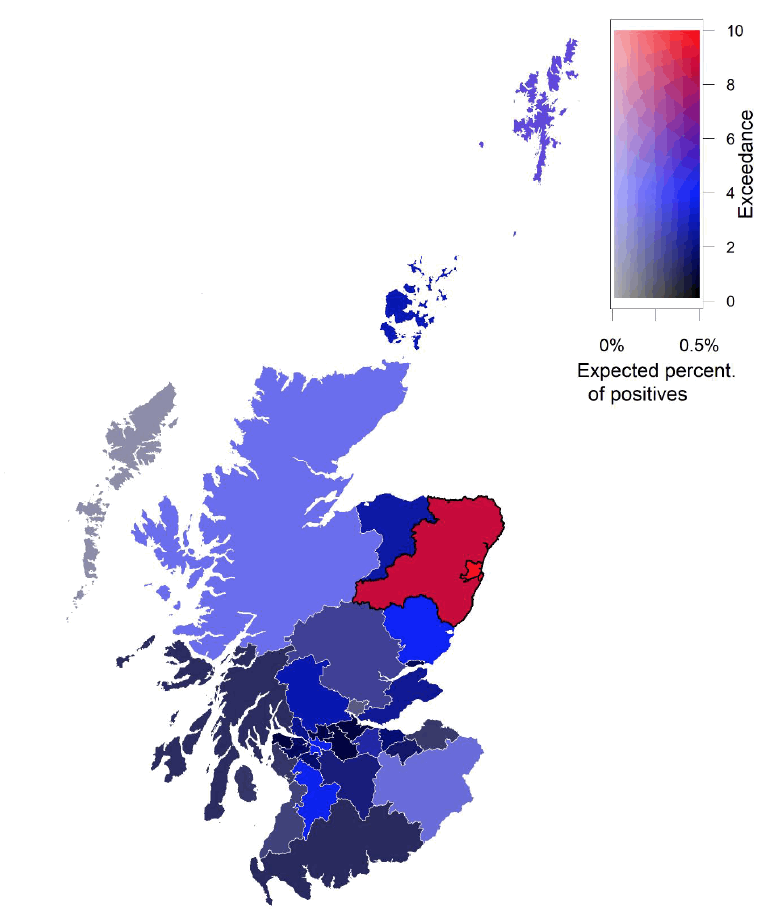
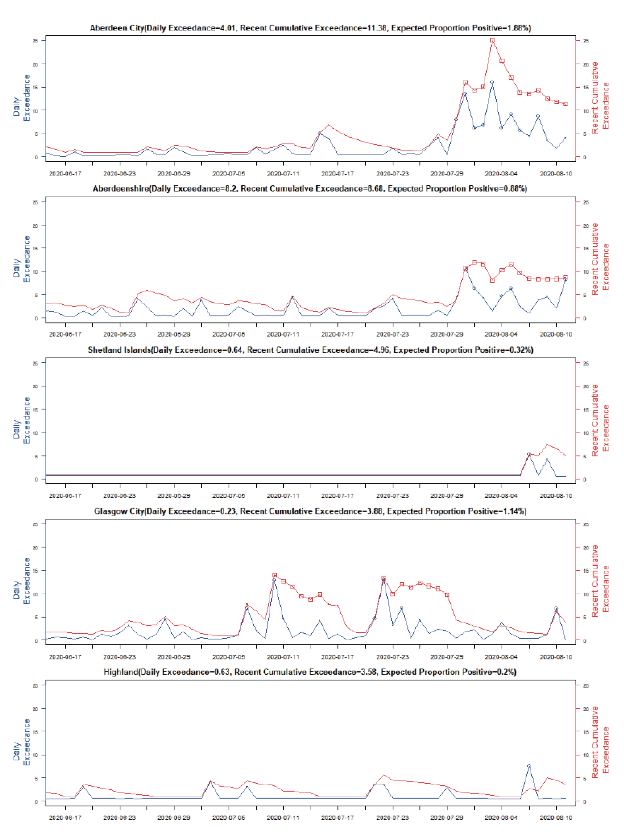
What next?
The modelled estimates of the numbers of new cases and infectious people will be provided as measures of the epidemic as a whole, alongside which, new measures of the current point in the epidemic, such as exceedance, will be reported each week. Where appropriate, Rt will also be provided. Next week we will introduce modelling which examines changes in contact patterns to provide the earliest possible indicator of a change in R.
Further information can be found at https://www.gov.scot/coronavirus-covid-19
Technical Annex
This technical annex outlines the new modelling work included in this research findings on exceedance.
Exceedance is defined by Health Protection Scotland as a: greater than expected rate of infection compared with the usual background rate for the place and time where the incident has occurred[1], we assume that the daily number of new positive cases should fall within a certain distribution of values, given the number of tests carried out each day, and the proportion of those we expect to be positive. The probability of getting the observed value of positive tests or greater can then be calculated. If this probability is small, the daily number of positive cases is much larger than would be expected by chance. We can now provide this at Local Authority level in Scotland using a model developed and run by Warwick University using Scottish testing data.
We can aggregate positive test results across several days to identify periods when the proportion of confirmed infections is high. This "cumulative exceedance" measure is more robust as it smooths variability in the data caused by, for example, multiple cases within larger households. As this cumulative exceedance value falls back to background levels, we can be confident that any outbreaks have been dealt with, as can be seen in the results for Dumfries and Galloway, in relation to the localised outbreak seen at the end of June (Figure 6).

Daily Exceedance
The daily exceedance is a measure of how far above the expected number of positive test today's results are, based on the number of tests, the national tests and the particular attributes of each Local Authority. The expected proportion of positive tests EP for a given Local Authority is based on the daily pattern of positive tests from elsewhere in the country (and hence naturally accounts for the impact of both a declining epidemic and the impact of weekend effects); this value is scaled by the mean proportion of positive tests in the Local Authority over the past six weeks. We assume that the daily number of new positive cases should be drawn from a beta binomial distribution for the given number of tests and the expected proportion positive. The probably of getting the observed value or above can then be calculated. When this is small, the daily number of positive cases is much larger than would be expected by chance. We define the exceedance as:
- log (probability of getting today's number of positive cases or higher by chance)
Large values correspond to highly unlikely large positive values.
Recent Cumulative Exceedance
We can apply this approach backwards in time, to assess whether a Local Authority has had consistently high values over a period of many days. Again assuming a beta binomial distribution, we calculate the probability of observing the given cumulative number of positive cases over a given period compared with the expected number.
Contact
There is a problem
Thanks for your feedback